 |
||
|
||
| ||
TABLE OF CONTENTS
As soon as a new 3D flagship enters the market (only one!), we can expect it to be followed soon by a successor, its junior brother. At the end of June NVIDIA launched GeForce 7800GTX. So we are waiting for a slower card in August - GeForce 7800GT. GeForce 6800GT differs from the 6800Ultra only by frequencies. The 6800 not only operates at low frequencies, its pipelines are also reduced to 12 per a core. The 6600GT has still fewer pipelines, but it has higher frequencies. In case of the GeForce 7800 series, designers tried another tack. GeForce 7800GT got lower frequencies as well as the reduced number of pipelines in its core (by one pixel quad and by 1 vertex pipeline). Of course, it's not yet announced, information from Internet is only preliminary, so we can only keep it in mind. So, the 7800GT is expected to have 20 pixel and 7 vertex pipelines and to operate at 400/1000 MHz. We have reached the main point of our today's review: can we use RivaTuner to reduce the number of pipelines in the G70? - Yes, we can. Can we reduce the frequencies? - Yes, we can. That is we can emulate the 7800GT from the 7800GTX. Of course, even if the information is precise and the final modification of the new product from NVIDIA has these characteristics exactly, we'll have to lump it that the drivers will currently see the 7800GTX, not the GT. We don't know what optimizations for given products are implemented in the drivers. Perhaps the real GT will be faster than the one we emulate today. Why does this 7800GTX article deal with the GT issue? The answer is simple: it's another reference card, which is no different from the one we initially reviewed. Of course, we shall describe this card as well, but the majority of readers will probably be bored. So I decided to show the 7800GT potential before this card is announced, it will certainly be more popular, due to its price first of all.
Now almost all articles will include video clips, which will be brief but more illustrious concerning a new product. There will be three formats: the best quality (MPEG1), average and low quality (WMV). So,
The previous card operated at initially higher frequencies than the reference card (that's why we tested this card), but the current product works at the same nominal frequencies specified by NVIDIA. So there is no point in additional tests and comparisons. If you still want to read about the performance of the new card, you can follow the links at the end of this article to the roundup, where one of participants is GeForce 7800GTX. But at first, let's examine the 7800GT card emulated by the 7800GTX.
Let's return to our card. Video card
As I have already said, all G70 cards are as like as two peas. Here is a copy of the reference card, which is no different from the one we reviewed in the base article. We have information that all NVIDIA reference cards (including this card) are manufactured on Leadtek plant (it's Foxconn now). This info is not 100% reliable, but this may quite as well be true.
The product has VIVO, where VideoIn is based on Philips 7115. The whole last year we were surprised why the entire GeForce 6800 series was not equipped with such coders, though PCBs provided empty seats for them. Nobody could explain why none of NVIDIA's partners installed such a chip on its cards. And now a video input is good news. 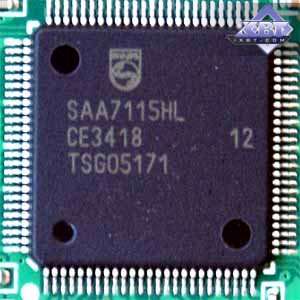 We should also mention that the card is equipped with a couple of DVI connectors.
The cooling system was thoroughly examined in the base article about G70. I will just remind you that the central heatsink is connected with a heat pipe to the memory heatsink. Let's proceed. The device is rather slim, it takes up only a single slot, which is good news (we are tired of bulky accelerators). Memory chips on the back of the PCB are cooled by a narrow plate. On the whole, the cooler is not noisy. Only the first seconds after startup are a tad noisy because of the high rpms of the turbine. You can hear the noise in this video (1.5MB, WMV) (note that the turbine does not start up immediately after the computer is turned on). Leadtek designers stick their plastic emblem to the cooler edge, which looks good on this card.
Bundle
Box.
Installation and DriversTestbed configurations:
VSync is disabled. Overclocking: the video card managed stable operation with its core overclocked to 513 MHz (note that the ROP/Shaders frequency can be changed at 27 MHz steps, so the card can be overclocked to 457, 486, and 513 MHz. Information about overclocking to 500 or 505 MHz, published in some other sources, is pure profanation. Only geometry unit can change its frequency continuously, depending on what main frequency you specify). The memory limit is 1370 MHz. We already obtained such overclocking results, so there is no point in republishing performance diagrams for these operating frequencies.
The GTX card is easily converted by RivaTuner (written by A.Nikolaychuk AKA Unwinder) into GT.
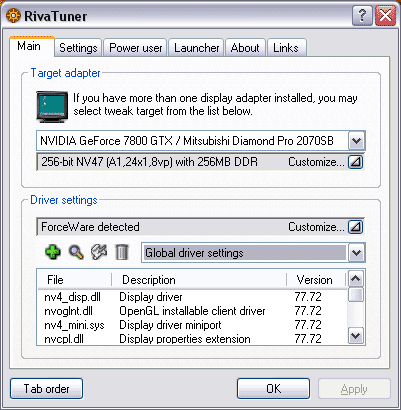 These are initial 7800GTX parameters.
Now let's lock one pixel quad (4 pipelines) and 1 vertex pipeline:
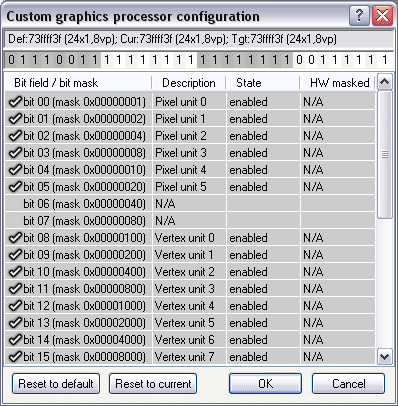
That's what we get:
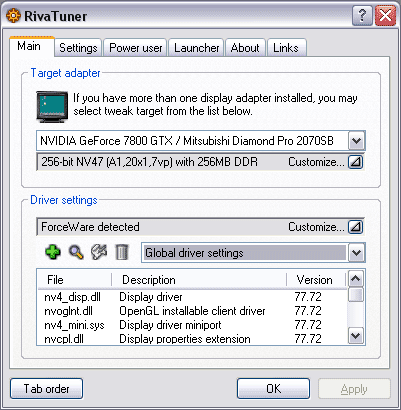 And finally, let's set the frequencies to 400/1000 MHz.
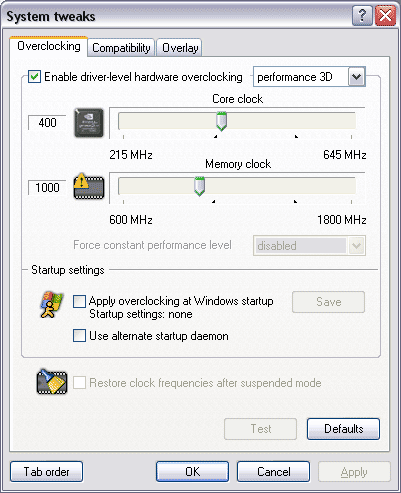
We monitored card's temperature during operation, there were expectedly no special differences from GTX. The core got heated maximum to the same 80-82°. 
Test results: performance comparisonWe used the following test applications:
Game tests that heavily load pixel shaders 2.0.TR:AoD, Paris5_4 DEMO The most "shader-intensive" game shows that the 7800GTX is appropriately beyond competition, while the emulated 7800GT ranks right between the GTX and the 6800 Ultra. At least it's faster than the latter. Considering X850XT PE frequencies as well as the efficiency of shader units in the latest generation of ATI chips, 7800GT (from GTX) has a weaker advantage.
Game tests that heavily load vertex shaders, mixed pixel shaders 1.1 and 2.0, active multitexturing.FarCry, Research FarCry, Regulator
 FarCry, Pier I guess we can ignore the results without AA+AF, as in case of weak load the performance is limited by a CPU. But in case of AA+AF we can see that the 7800GTX is still in the lead, no comments are necessary. What concerns the 7800GT (from GTX), even though its performance is reasonably between the 7800GTX and the 6800 Ultra, the X850XT PE is sometimes faster. However, we should take into account that the price for the latter card is quite high. Besides, this product is already disappearing from the shelves. F.E.A.R. (MP beta)
 This game combines strict 3D requirements and plenty of modern graphics technologies. So the 7800GTX demonstrated the most prominent advantage over its all competitors. That's probably the most illustrious example that gives food for thought - what if all modern games are that exacting, it makes the retiring High-End representatives the minimum requirement to provide decent gameplay at maximum quality (even without AA+AF!). The 7800GT (from GTX) shows that it has insufficient memory bandwidth. Indeed, 1000 MHz of memory is not enough even with a 256bit bus for a 20-pipeline GPU! Memory in the 6800 Ultra (with its 16 pipelines) operated at 1100 MHz. That's why this card is defeated at high resolutions not only by the ATI competitor, but also by its predecessor - the 6800 Ultra. But let's keep in mind that the 7800GT price may be more attractive than that for the 6800 Ultra.
Game tests that heavily load both vertex shaders and pixel shaders 2.0Half-Life2: ixbt01 demo
 Half-Life2: ixbt02 demo
 Half-Life2: ixbt03 demo
 Unfortunately, this test is even more critical to a processor, so the performance is limited by the system resources even with AA+AF. In other respects the situation is similar to the previous case: the 7800GTX is victorious, the emulated 7800GT demonstrates intermediate results between the GTX and the 6800 Ultra; it's sometimes on a par with the X850XT PE.
Game tests that heavily load pixel pipelines with texturing, active operations of the stencil buffer and shader unitsDOOM III High mode Chronicles of Riddick, demo 44
 Chronicles of Riddick, demo ducche
 The X850XT PE puts up a bad show in all these tests. We have discussed this issue many times (a short pipeline, little caching during texturing, weak stencil-buffer operations, etc. - these are strong points of NVIDIA products), that's why it's an outsider. In other respects, the GTX is certainly the leader of the season. The emulated 7800GT demonstrated intermediate results between the GTX and the 6800 Ultra. But as we can see, insufficient memory bandwidth resulted in the minimum gap from the 6800U with AA+AF (this fact backs up the above words that a 20-pipeline chip shouldn't be shod with such a narrow memory bandwidth).
Synthetic tests that heavily load shader units3DMark05: MARKS The results are similar to those in TR;AoD, where everything is up to the capacity of shader units. Of course, the 7800GTX is the leader, it's followed by the 7800GT (from GTX), then goes the X850XT PE, and the 6800 Ultra brings up the rear.
Conclusions
Leadtek WinFast PX7800GTX TDH MyVIVO 256MB is an excellent product, if you want the most powerful accelerator and have enough money for it. An excellent bundle. On the whole it's an attractive product. As it's just another reference card, there is no point in describing new features added by the manufacturer. Actually nothing was added, but this bundle is more attractive than the others at the same price. However, GeForce 7800GTX from Gainward , reviewed in the previous article, may prove more attractive due to increased operating frequencies, if its price is not raised relative to the average level. It's a pity that Leadtek, well-known for its engineers and designers, introduced nothing new into this product and limited itself to changing the box design and a sticker on a card. We can still remember a unique copper cooling system and other interesting solutions. Alas. This video card is very stable, 2D quality in this sample is up to the mark: 1600x1200@100Hz - excellent sharpness. If it's true that the reference cards are manufactured by Leadtek, I won't be surprised, as products from this company have been famous for their excellent quality.
You can find more detailed comparisons of various video cards in our 3Digest.
Leadtek WinFast PX7800GTX TDH MyVIVO 256MB gets the Excellent Package award (August).
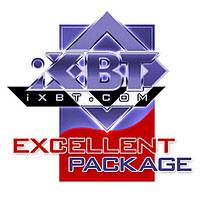
Theoretical materials and reviews of video cards, which concern functional properties of the GPU ATI RADEON X800 (R420)/X850 (R480)/X700 (RV410) and NVIDIA GeForce 6800 (NV40/45)/6600 (NV43)
Write a comment below. No registration needed!
|
Platform · Video · Multimedia · Mobile · Other || About us & Privacy policy · Twitter · Facebook Copyright © Byrds Research & Publishing, Ltd., 1997–2011. All rights reserved. | |||||||||||||||||||||||||||||||||||||||||||||||||||